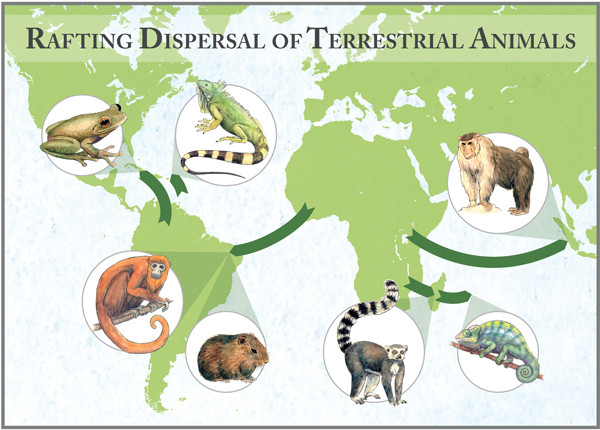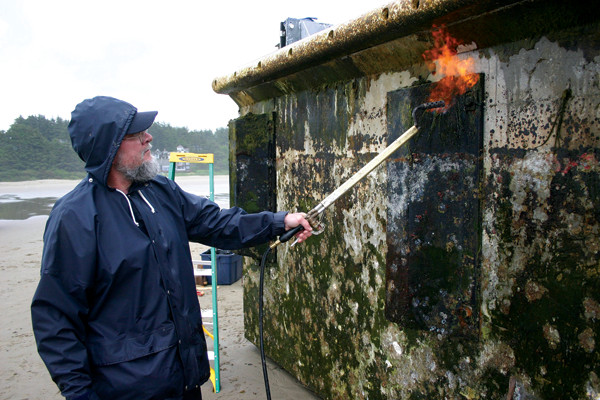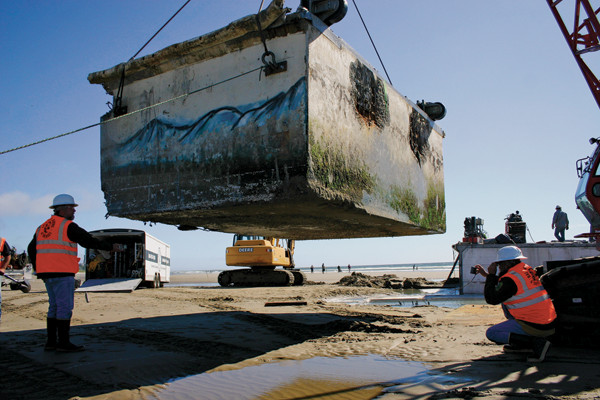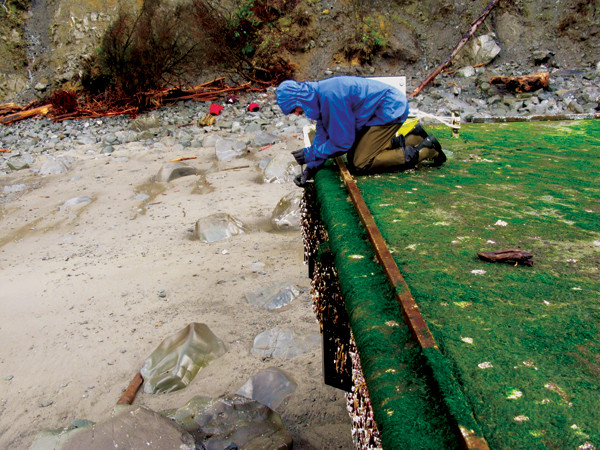
by Mary Caperton Morton Monday, February 11, 2013

This map portrays a few examples of modern animals whose ancestors dispersed by voyaging on natural rafts across open water, including lemurs, which rafted from Africa to Madagascar, and chameleons, which rafted from Madagascar to islands in the Indian Ocean. Rafting routes are delineated by the green arrows. Kathleen Cantner, AGI

Removal of the dock at Agate Beach was a public process; people were very interested in its progress. Courtesy of the Oregon Parks and Recreation Department

A section of the dock will be preserved in Newport, Ore., as a memorial to the victims of the earthquake and tsunami. Courtesy of the Oregon Parks and Recreation Department

Examining the dock that washed up on the coast of Washington in December posed quite a challenge: Researchers had to ford deep, cold streams, hike through forests and across logs and use a rope line to descend to the beach. Courtesy of the National Park Service and the Washington Department of Ecology
On June 5, 2012, several thousand castaways rode a massive boxcar-sized dock to landfall on Oregon’s Agate Beach, just north of Newport. A plaque on the side, written in Japanese, revealed an unprecedented journey: The dock had been unmoored from the Japanese coastal city of Misawa during the catastrophic tsunami on March 11, 2011.
The dock and its inhabitants — as many as a hundred species, including mollusks, anemones, sponges, oysters, crabs, barnacles, worms, sea stars, mussels and sea urchins — spent more than a year at sea, drifting 8,000 kilometers across the Pacific Ocean. Within hours of the dock’s discovery, marine biologists from Oregon State University’s Hatfield Marine Science Center were on the scene, identifying species and raising red flags.
“Very quickly we realized we were dealing with a cast of very bad characters,” says John Chapman, an Oregon State University marine biologist who was among the first on the scene. And it was not a small cast: More than two tons of living organisms would eventually be removed from the 20-meter by 6-meter by 2-meter dock. “This was essentially an intact subtidal community of Asian species, aliens fully capable of reproducing, colonizing and invading the Oregon coast,” Chapman says.
The arrival of the dock and its species came as a shock: “Before June 5, 2012, we would have said it was impossible for something like this to happen,” Chapman says. “The notion of an intact coastal community surviving a year-long crossing of the Pacific is incredible.”
Of course, over geologic time, incredible journeys like this have occurred before: Primates rafted from Africa to South America, lemurs forded a 400-kilometer-wide channel from mainland Africa to Madagascar and plants colonized the farthest ice-free reaches of the Arctic. “On an evolutionary timescale, rafting has played a tremendously important role in the dispersal of organisms around the globe,” says Martin Thiel, an evolutionary biologist at the Catholic University of the North in Coquimbo, Chile.
But while long-distance rafting events have occurred throughout the history of life on Earth, the geologically recent advent of human settlement, culture and infrastructure is fundamentally changing the rafting game. “Rafting was once a rare phenomenon,” Thiel says. “Now it’s happening everywhere, all the time and we don’t yet know the consequences.”
[Rafting may be one of the most important means of species dispersal around the planet, but the phenomenon is not well studied, even within the burgeoning field of “movement ecology,” says Ran Nathan, an ecologist at Hebrew University of Jerusalem in Israel.]{style=“font-size:14px;”}
“In certain areas with short distances between islands, we know rafting events happen all the time, but even those are rarely observed,” Thiel says. “Long-distance events are very rare and unpredictable and almost never seen. We can only study the effects.”
Before the Japanese dock washed up on Agate Beach, the last well-known modern case of long-distance rafting occurred in 1995, when a dozen or more green iguanas were seen swimming ashore from a floating mat of uprooted trees to the Caribbean island of Anguilla, which had previously been iguana-free.
The castaway iguanas were spotted by fishermen a few weeks after Hurricanes Luis and Marilyn swept through the islands. Based on storm patterns and currents in the region, the iguanas were traced to the island of Guadeloupe, located several hundred kilometers to the southeast. The event was reported in Nature in 1998, after a survey found reproductive male and female iguanas on Anguilla, confirming that the non-native lizards had survived and colonized the island.
“The iguanas rafting to Anguilla is probably the best-known modern case of rafting, but even that is still considered anecdotal,” says Blair Hedges, an evolutionary biologist at Penn State University. “[The event] was reported by fishermen. We don’t have photos. We weren’t able to track the raft across the Caribbean.”
Despite the relative lack of firsthand evidence for modern rafting, biogeographers still cite transport via floating debris as one of the primary movers of nonswimming, nonflying organisms around the planet over geologic timescales.
Perhaps the most famous example of rafting is the colonization of the island of Madagascar across 400 kilometers of open water from Africa. Madagascar appears to have been an island for at least 120 million years. Genetic studies suggest that animals began arriving about 60 million years ago. Geologic evidence for land bridges or island chains during this window has never been found, leaving rafting as the most likely explanation.
“The rafting hypothesis has been well explored; it’s really been a process of elimination,” says Ann Yoder, an evolutionary anthropologist at the Duke Lemur Center in Durham, N.C. “It’s kind of crazy to imagine lemurs clinging to vegetation and rafting across the Mozambique Channel,” she says. “But time and time again, it really seems to be the best fit for the data.”
Today, water currents are not conducive to transport across the Mozambique Channel; a strong southward gyre flushes currents south into the Indian Ocean. But about 60 million years ago, when the first inhabitants likely reached the island, both Madagascar and Africa were more than a thousand kilometers south of their present positions, placing the landmasses in a different gyre that would have flowed steadily east, toward the island, according to a 2010 study in Nature.
Once the researchers established that the crossing could have happened, they needed to figure out why it didn’t happen more often. Genetic studies suggest that Madagascar was populated by a very small number of founders.
“Madagascar [had] very few colonization events,” says Matthew Huber, an oceanographer at Purdue University and the lead author of the Nature study. “There’s a delicate balance of having to explain how animals got there at all versus why they didn’t get there more frequently. It had to be a ’lightning bolt’ event.”
Using complex modeling methods, Huber showed that surviving the trip to Madagascar would have required more than just a change in currents. In a thousand-year simulation, they found a narrow window of only a couple of months where the currents were moving fast enough that a raft could make the trip in a few weeks.
A small animal might not die of starvation in a few weeks, but it could die of thirst. A tropical cyclone, however, might have pushed the raft a bit faster, providing freshwater in the form of rain along the way. “The cyclone scenario tips the possibility over into the ‘just likely enough that it’s possible but still so unlikely that it’s not going to happen often’ category,” Huber says.
Within 20 million years, as the continents drifted northward, the currents gradually changed, shutting down that slim chance of transport across the channel and isolating the island and its inhabitants from mainland Africa.
Madagascar’s lemurs may not seem like ideal candidates for rafting the high seas, but primates possess the most important skill for successful rafters: the ability to hold on to the raft. “The majority of potential rafters are lost in the first moments of the voyage,” Thiel says.
To date, evidence for successful rafting has been found in more than 1,200 species, including plants, invertebrates, insects, reptiles, amphibians and mammals. “There is a mismatch between the relatively low number of species with known specialized adaptations for rafting and the much larger number of species that have been recorded as rafting,” Nathan says.
“Some species are better suited to rafting than others, but I’m always amazed at the diversity of organisms that seem to have survived long voyages,” Hedges adds.
Successful rafters should be able to make a living on the raft, by catching prey, photosynthesizing, or eating bits of the raft itself. Some species are thought to survive their crossings by entering a hibernation-like state, while some species of lizards and frogs can survive months of desiccation, he says.
On long voyages, rafters should also be able to reproduce on board, likely through asexual reproduction or internal fertilization. Species that are born fully developed, without going through an intermediate larval phase that requires incubation in water also are more likely to be transported via rafts, Thiel says.
Once a raft makes landfall, the organisms then have to colonize the new habitat. “Not all organisms are equally suited to colonization,” Thiel says. “It’s important that the raft reaches suitable habitat and that the organisms can gain a foothold.”
Genetic studies have shown that in some cases, one pregnant female is enough to found a new population. The 70 plus species of lemurs on Madagascar are thought to be descended from a very small original population. But “it’s a mystery what the original founding population would have looked like,” Yoder says. “Was it a single pregnant female? Or a handful of individuals of both genders?”
The island of Madagascar — a landmass twice the size of Arizona — has more unique animal species than any location on Earth except Australia, which is 13 times larger: 90 percent of the mammals, amphibians and reptiles on Madagascar are entirely unique to the island, including the 70 species of lemurs seen nowhere else on Earth. Competition in the island environment led to radical diversification, likely driven by avoidance of resource overlap between species, Yoder says.
“Part of the species richness that we observe in island environments is a reflection of this kind of colonization event where transport occurs en masse and then is cut off,” Thiel says. “Populations that are established via rafting often don’t have opportunities for genetic exchange with neighboring populations, an evolutionary scenario that often leads to extreme diversification.”
Natural rafts have likely been ferrying organisms around the planet since the very beginning of life on Earth. Floating volcanic pumice is thought to have been one of the first modes of transport. But anything that floats can be used as a raft: algae mats, detached wads of kelp, dead whales, ice floes, volcanic pumice, uprooted trees, docks, or plastics.
Not every raft is a desperate lifeboat. Storms and flooding events have been known to rip away huge floating chunks of earth, veritable yachts, complete with living vegetation, upright trees and miniature ecosystems. “Not just bits of vegetation, but whole islands, more than a mile in diameter, so solid that you could climb aboard and walk around,” Hedges says.
But while rafts of all shapes and sizes have been in play for billions of years, they tended to be “sweepstakes” events, a term coined in the 1940s by paleontologist George Gaylord Simpson, one of the first advocates of the Madagascar rafting hypothesis.
“Volcanic pumice has been around for a long time, but pumice-rafting events are typically rare,” Thiel says. “In many areas of the globe, hundreds of years may go by between eruptions. Then, for a while, there is an enormous supply of floating pumice and tremendous opportunities for organisms to be transported. And then the pumice washes up or sinks and it’s over.”
In the past few hundred years, human activities have fundamentally changed the type, availability and longevity of potential rafts, Thiel says. For example, widespread logging in North America starting in the mid-1800s and continuing through the 20th century sent a tremendous number of felled trees down rivers and out to sea through the common practices of log driving and timber rafting.
Logging’s heyday doesn’t come close to the changes wrought in the past few decades, he says. “The biggest change has been the development of plastics,” Thiel says. Studies have found that the same organisms that once rafted on volcanic pumice now raft on plastic. “From the perspective of the organisms, it’s the same, whether they travel on pumice or plastics, as both are abiotic substrates,” Thiel says. “The only difference is that plastics usually last longer at the sea surface.”
The other big difference, Thiel says, is that plastic is everywhere. “Rafting opportunities for organisms are much higher now than they have been at any time in the past,” Thiel says. What this will mean for the spread of invasive species and the health of native ecosystems is not well understood — and it is concerning.
The arrival of the Japanese dock in Oregon marked a new era for rafting: the potential spread of Asian organisms around the Pacific on tsunami debris. Despite the long voyage at sea, the majority of the organisms found clinging to the dock were not native to the open ocean; these were not drifters that are often washed up on foreign shores, Chapman says.
The castaways were coastal species, native to Japan. Several species, including a European blue mussel (itself an invader of Japan), an Asian brown seaweed, an Asian shore crab and a Japanese sea star were already implicated as potentially dangerous invasive species, but many others had never been seen before on U.S. shores.
“If things routinely drifted across the ocean, from shallow water systems in Japan to our shallow water systems, our coasts would look alike, but they don’t,” Chapman says. “This is an enormous scientific question. There was clearly once a barrier there. I hope there still is.”
Within a day of its arrival in Oregon, the dock was photographed, sampled, scraped clean and blowtorched in an effort to contain the threat of invasion. More than two tons of organisms were then entombed in a hole on Agate Beach well above the high tide line. The dock was eventually dismantled, with a few pieces earmarked for a future memorial for the thousands of victims of the 2011 earthquake and tsunami, to be built in Newport, Ore.
“The speed at which everybody mobilized to contain this problem was incredible,” Chapman says. “We couldn’t have done it faster or more thoroughly.” But the threat of invasion isn’t over. As the dock washed ashore, its underside scraped along the seafloor, releasing untold numbers of organisms into the surf. “There’s no telling what crawled away,” Chapman says.
The dock isn’t the only raft out there. Three other sister docks were also lost during the tsunami. Two washed up on Japanese beaches. The fourth was seen off the coast of Hawaii last fall, but disappeared before the Coast Guard could get a lock on tracking it. Then in December, a dock about the same size and style as the Oregon dock washed ashore on Washington’s Olympic Peninsula, which has been confirmed to be the same dock seen off Hawaii — the fourth tsunami dock.
After the March 2011 disaster, the Japanese government estimated that approximately 5 million tons of debris had been swept into the Pacific Ocean by the tsunami. As much as 70 percent is thought to have sunk relatively close to the Japanese coast, leaving about 2 million tons unaccounted for. Modeling studies by NOAA and other groups predicted debris would begin to make landfall on the northwest coast of North America starting in the winter of 2011 and would possibly continue for several years.
Tsunami debris has washed up in Hawaii and along the west coast of North America, though none has been as large as or as extensively studied as the Agate Beach dock. “The dock that washed up here had been at sea for 451 days,” Chapman says. “We have no way of knowing how fast [the onboard ecosystem] might degrade at sea. How many species were on it when it left Japan? We don’t know.”
How rafting might continue to evolve in the future in response to climate change is also a big unknown. In some species, a northward shift seems already to be under way.
In the Arctic, plant species have been documented colonizing newly ice-free habitats at a much higher rate than predicted. So far, the modes of northward dispersal are not clear. Few species of Arctic flora are adapted for dispersal by birds, and even those are not easily spread northward: Plants produce ripe seeds in the fall when birds are heading south for the winter, suggesting that migrating birds are unlikely to play an important role in northward expansion due to climate change, Nathan says.
Dispersal via rafting events, possibly on chunks of ice, may be playing a role. “Only a few hundred species of higher plants have clear adaptations for prolonged floating, but a much wider range of species has been recorded as rafting,” Nathan says. For example, of the plant species that colonized the newly emerged volcanic island Surtsey, off the coast of Iceland, in the first decade after it emerged from the waves in 1963, 78 percent were identified as having arrived via ocean currents. However, only 25 percent of those had apparent morphological adaptations for dispersal in water, suggesting the rest had somehow hitched a ride on a raft.
Regardless of the mode of transport, “Arctic dispersal events seem to be much more common than we realized,” says Inger Alsos, a botanist at the University Centre in Svalbard in Norway. For many plant species, climate change can decrease their range, leading to a loss of genetic diversity. However, “plant species that are adapted for long-distance seed dispersal seem to be losing less genetic diversity as a result of climate change.”
Whether the dispersal will be able to keep pace with climate change is unknown. “Based on modeling studies, we see efficient dispersal over 10,000-year timescales,” she says. “It seems that in the long term, plants will be able to keep pace with changing conditions.”
Uncertainty seems to be a theme with rafting, throughout the past, present and future. Rafts of human-made debris could lead to the more rampant spread of invasive species or they could provide a lifeboat for species threatened by climate change to set sail for new habitats. Nobody knows.
“We need more of everything: more modeling, more fieldwork, more dispersal events,” Thiel says. “The tsunami was a horrible tragedy, but [the debris] is creating a rare opportunity” to study long-distance rafting, especially in terms of how voyages may be affected by climate change: Intense storms, higher sea-surface temperatures and increased UV radiation are just three of the many potential factors that need to be quantified, he says. As the oceans warm, changes in ocean currents on regional scales may also open new avenues for rafting, especially in the higher latitudes where the breakup of sea ice is opening new channels and potentially creating floating ice ferries.
In the future, rafting opportunities will largely depend on changing environmental conditions on a localized scale, Thiel says. “Climate change may open new dispersal pathways in some places and close them in others. We’re moving into a new era and we don’t yet know what the future holds.”
© 2008-2021. All rights reserved. Any copying, redistribution or retransmission of any of the contents of this service without the expressed written permission of the American Geosciences Institute is expressly prohibited. Click here for all copyright requests.